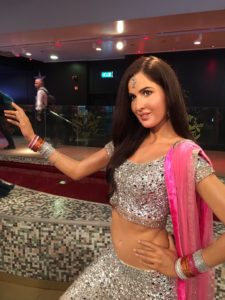1st July 2019 London,UK
Waxing Lyrical

Madame Tussauds is one of those attractions that Londoners tend to dismiss as aimed mostly at visitors to the city. And it is not the easiest of places to get in, as the successful navigation of a queue to buy a ticket earns you a place in another queue to enter the museum.
But it has a venerable place among London’s tourist attractions: a museum for some 180 years, in its current location since 1884. Madame Tussaud herself is a fascinating figure. Born in France in 1761, she learnt the art of wax modelling from a physician named Philippe Curtius. A model of Voltaire sculpted by Tussaud in 1778 is to be found in the most educational room of the museum, devoted to the history of the place and the art of wax modelling, and there is an even older model from Curtius’s collection, that of Madame du Barry, mistress of Louis XV and victim of the French Revolution, in a “sleeping beauty” pose. Madame Tussaud herself, whose subjects included the ill-fated French Royal family, narrowly escaped the guillotine during the Revolution, and moved to London during the early nineteenth century. Initially travelling with her wax collection around Britain, she opened a museum in Baker Street in the 1830s. The museum today includes her self-portrait, dressed sombrely in black.
The history of the museum occupies but one small space in the tour today. You enter past Marilyn Monroe into an A-list Hollywood party. Madame Tussauds is catering to a truly global cast of visitors, so that party includes Bollywood stars like Katrina Kaif alongside the Hollywood A-listers. Then tableaux in homage to blockbuster movie franchises, from James Bond to Shrek. Madame Tussauds displays its modernity with a room dedicated to YouTube vloggers, with Zoe Sugg and Alfie Deyes sitting together on a bed, though I fear in my lack of modernity these two names meant nothing to me. Then sports stars: Ronaldo; Tendulkar; Pele; Muhammad Ali. With a nod to home-grown heroes, from Bobby Moore to Jessica Ennis-Hill.

Then some British pageantry: Henry VIII; Shakespeare; Victoria. And a noticeable focus on the Royal Family, with quite a queue for photographs with Her Majesty and the Duke of Edinburgh. Science and art are covered cursorily: Einstein, Newton, Dickens and Van Gogh. And then the displays move on to US politicians: Obama, Martin Luther King, Kennedy and Trump, the latter topically placed outside the door of No 10 Downing Street just days after his State Visit. Other world leaders are restricted to Modi and Jinping.
Then to pop stars, where the museum returns to the bountiful treatment it offered to the stars of screen. From the Beatles to Ariana Grande, via Elvis, Hendrix, Freddie Mercury and Adele.
The second half of the tour has more the flavour of theme park style attractions. “The Spirit of London” turns out to be a whistlestop history of the capital from aboard a ride decked out as a London taxi: blink and you miss the Great Fire as you glide past. The venerable Planetarium remembered from school trips is long gone: beneath its green dome you now get a 4D movie featuring Marvel characters in a plot about a dastardly plan to destroy London by taking out the Superheroes Command Centre based at, you guessed it, Madame Tussauds. And you end up at a Star wars exhibit, stuffed full of opportunities to have your photo taken with Darth Vader or Yoda, for purchase at the shop on the way out.

One panel in the museum claims that “Madame Tussauds defines fame”. And the place today is a marker of global celebrity: of those whose influence transcends cultures. But it is also defined by place: it is a museum for visitors to London, who want an experience which is identifiably British as well as covering the global celebrities who are too major to omit. But this British experience is focused on the aspects of Britain of which this international audience is aware and interested. What do the choices made here tell us about our soft power? That our Royal Family exerts a powerful global attraction. The various tableaux devoted to members of the Royal Family are among the most popular spots for posed photos, with the Duke and Duchess of Sussex current major draws. Kings and Queens in our past feature heavily too, as does our history. We score particularly well in music, with a respectable showing in sport and science. London Fashion Week gets a nod. But in this global family-friendly attraction the edginess of Madame Tussauds of old has been smoothed out. There is no longer a Chamber of Horrors. Instead, we are left with Marvel Superheroes and Star Wars. Celebrity, it seems, has become too major to be left to real, fallible, people.
And is Madame Tussauds itself an example of British soft power? It is certainly a successful global brand, which from its original London location has now spawned museums around the world: seven in the USA; four in China. Its ownership has switched in recent years from organisations headquartered in the United Arab Emirates, to the UK and, with recent news of a buy-out to the group which founded Lego, to Denmark. And it was born out of the genius of a Frenchwoman. Its strength it seems lies in the exchange and development of ideas across borders.